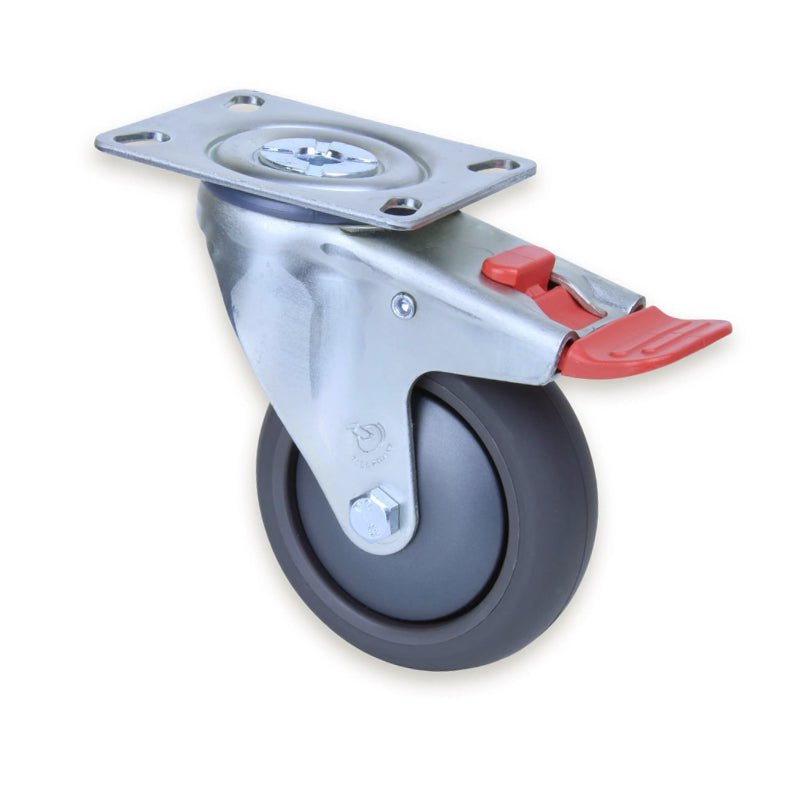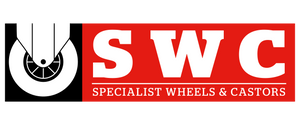
Castor mounting and maintenance
Correct Castor Fitting:
Castors will not swivel properly unless they are mounted vertically, otherwise they will track to one side.
Heavy trolleys need plate mountings, but the base of the trolley must be strong enough to withstand the load. Never mount a plate castor by three bolts only. Never skimp on the mounting base.
You can get up to 8 mm of adjustment with washers, or an off cut of tube tightly jammed between leg and castor—but do not let it float. Tighten tubular fittings firmly, but do not over-tighten.
You should retighten castors after 3 months of use, and annually after that. We recommend ‘3 finger’ tightness—the amount of torque you can get onto a standard spanner using your 3 middle fingers.
Tube fittings
Medium duty castors are often mounted into tubular legs. But again, it is important that these legs stay vertical.
We recommend that the leg never extend more than 125 mm below the nearest support, and (apart from the lightest uses), the tube should be 1.4 mm thick or more. Thinner gauges often split. If you wish to use lighter gauge in the rest of the trolley, insert a sleeve for at least 150 mm where the castor is mounted.
Never put a round expanding fitting into a square tube as when the trolley hits a bump, the tube is likely to elongate, and the castor may fall out. We do have square fittings, and ask that you use them. If for some reason you need to put round into square, then weld an insert sleeve of round tube (remember—our smallest fitting needs 3/4” ID). When using Directional Lock (DL) type castors it is best to use the solid swivel stem and weld or bolt it in—screwed types can become misaligned. To achieve the best performance from the larger 175 mm and 200 mm castors use solid stems.
When fitting expanding stem castors, make sure that the fitting is fully inserted into the tube, with the tube firmly down onto the castor head rivet, before tightening it up (you may have to remove some of the burr on the inside of the tube before you try to push the fitting in). After making sure the weld on the inside of the tube is not excessive, align it with one of the slots down the outside of the adaptor fitting. Put the fitting into the tube all the way, then put some sideways pressure on to it to help the fittings grip, then tighten the stem bolt firmly. Do not over-tighten, or you will make it hard to remove later. It is advisable that any tube fitting on expanding stem castors be checked after the first 3 months, and then yearly to make sure the tube fitting is fully and firmly into the tube and the tightening nut is firmly but not over tightened.
Greasing
Grease in both the swivel head race and the wheel serve three purposes:
-
Prevents rusting of the balls and raceways:
-
Prevents galling
-
Reduces noise
It does not need a lot of grease to do this. Too much is unsightly and only attracts dust. A liberal smear is all that is needed. If you only have a few castors to grease, use your finger to apply the grease, then wipe off the excess with a rag or use a needle tip grease gun.
If you have many of them we suggest the following:
-
Turn the trolley upside down and remove the wheels.
-
Re-grease the head, either through the grease nipple if fitted, or by a needle tip fitting on a grease gun. You will need to lift the seal on the heavier range of castors with a sharp pointed screwdriver. Two full squirts are usually adequate, but make sure enough grease gets through to the centre so it can descend to the bottom race.
-
Check the wear of the axle bushing. Reuse if not heavily worn, otherwise replace. Smear about a teaspoon of grease along the inside of the wheel bearing with your finger, taking care to force the grease up into the rollers and reassemble.
-
Be careful of the lip seal on the wheel as you reinsert the axle bushing into the roller bearing wheels. Make sure the axle bushing is clean as you reinsert it.
-
Reassemble the wheel into the castor. Replace washer where fitted. A drop of Locktite High Assembly Strength solution on the axle thread is a good precaution.
-
Use a No. 2 bearing grease (not sodium based).

